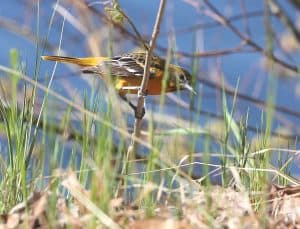
Did you know that many female birds sing? I didn’t, but read about the phenomenon in the summer issue of Living Bird. I had heard about the female rose-breasted grosbeak sometimes singing from the nest, and some years ago I witnessed this phenomenon. I heard the singing, assumed it was a male rose-breasted grosbeak and looked up into the tree. Astonishingly, it was the brown female grosbeak, sitting on her nest and singing. I had no idea that the phenomenon was as widespread as it is. Reading “The Forgotten Female” in the Summer, 2019 volume of Living Bird, I learned that in at least 1000 bird species worldwide, female birds sing. Most female singers reside in tropical regions. It is thought that this gives paired birds a better chance to defend their territories when visibility is low because of heavy foliage. Also it may be that non-migratory birds may sing because they need to defend territory year-round.
At least 144 temperate species are known to have female singers.
There are at least 48 New England species in which females sing. These include such well-known yard birds as northern cardinal, Baltimore oriole, house wren, tufted titmouse, black-capped chickadee, red-winged blackbird, scarlet tanager, and dark-eyed junco. Of course it is difficult to notice the female singing if both male and female have identical plumage, such as in the chickadee, titmouse, and house wren. But in those species that are dimorphic (different plumages) such as the cardinal, red-winged blackbird, scarlet tanager, rose-breasted grosbeak, Baltimore oriole, and dark-eyed junco, we may be able to identify a singing female.
In an article entitled, “A Call to Document Female Bird Songs: Applications for Diverse Fields”, published in The Auk, Ornithological Advances, April 2018, two researchers, Karen Odom and Lauryn Benedict call on citizen scientists to help them to document female bird songs. They state, “First, birders and researchers need to be aware that female birds regularly sing, and they need to take the time to evaluate the sex of singing birds. Second, we need documentation of female songs in the form of descriptions and recordings….For some species or scenarios, it may be difficult to distinguish what constitutes ‘song’ so we encourage the documentation and reporting of all interesting, elaborate vocalizations in females, as well as males.”
We can no longer walk blithely through the woods or our yard, confidant that the singing bird we hear is a male cardinal or a male oriole. We will need to get out our binoculars and camera, to determine the sex of the singer and take a video of it if possible. If you get any information on singing females in your area, you can send it in to Odom and Benedict at their website, femalebirdsong.org.
Many thanks to all flora and fauna reporters for the month of July. Please send reports by August 26 to appear in the next column. You can send reports to me at 7A Old Colony Drive, call me at 978-692-3907, or e-mail me at mariancharman@gmail.com.
Late June Reports
Peggy Bennett, at Depot St. June 4, fox with breakfast in his mouth. June 10 at Nabnasset St., two great blue herons (nesting pair), flycatchers in the rafters of the barn. At Tyngsboro Rd, Canada geese and six goslings. June 12, at Rolling Meadow, one turkey hen and five baby chicks. June 10, porcupine crossing Tyngsboro Rd. At Russell’s way, snapping turtle. June 17, Nabnasset St., ten to twelve cedar waxwings (my favorite) in our cherry tree–stayed about two days. June 26, at Nabnasset St., two barred owls calling to each other, a garter snake sunning.
Beth/Bruce Bonner, Plain Rd. June 21, saw our female turkey, June 21, 24, 27, 28 and 30, usually showed up late afternoon.
Alan Emmet, Concord Rd., June 29, saw a rose-breasted grosbeak at my feeder–a first for me. I have occasionally heard a barred owl and a screech owl at night. One day I heard a loud cat-like screech in the woods near me.
Barbara Theriault, Tadmuck Lane, June 30, doe and fawn, on sturdier legs, in back yard.
July Reports
Marian/Bill Harman, Old Colony Drive. July 1, 60’s, humid and sunny. Grackles all upset and strafing a crow which is coming to the suet. When he gave up, they chased him. This happened several times within an hour. July 2, 70’s, humid. On Lynwood Drive a nice gazebo planted with pollinator friendly plans, especially milkweed, but no monarch egg on them. Blue toadflax along road. Milkweed is flowering along Wright Cemetery wall. Ants and bumblebees are pollinating it. Heard song sparrow, goldfinches. A small tree along the trail at our condo is common hoptree. Cowbirds are now at our feeder. July 7, tiger swallowtail flying around near the deck. July 13, many fewer grackles at the feeder now, so the smaller birds can finally get seed and suet.
Frank Karkota, July 2, while on a walk, I saw seven medicinal plants: blackberries, slippery elm, mullein, red clover, yarrow, wild sumac, feverfew.
Barbara Theriault, Tadmuck Lane. July 4, turkeys, three adults and five chicks. July 6, return of the doe and fawn, much bigger now. Hummingbird flying back and forth over her nest with two mini white eggs on a low tree branch. She was disturbed by our annual croquet match. July 8, 11:30 p.m., pack of coyotes howling for several minutes. July 12, “hummingbird sitting on her nest–good news”.
Tom Ennis, Almeria Drive, July 6, solid coat, no spots–juvenile perhaps? [Tom sent a good video-MH]
Sue/Bruce Bonner, Plain Rd. July 10, the first ten days of July, we saw our turkey. She definitely seems familiar with us, steps aside while Bruce puts seed on the ground. July 14, a turkey ran up our front yard with her tail spread, stopped to eat blueberries and then ran around to the feeders. She was definitely in a hurry. She seems to come from across Plain Road. Sometimes she just strolls across the street, and several times she has flown over the speeding cars to avoid being hit. July 13, small young gray squirrel on our deck. A 3 inch hole in the barn now has a squirrel family living in it. July 16, coyote walked through the backyard with a small animal in its mouth. Two adult and two young woodchucks in yard. We see one or sometimes two hummingbirds at the lantana blossoming on our deck. Also the hummingbird likes the lambs’ ear perennial in my flower bed. On July 20, we saw a baby squirrel peeking out of the hole in the barn. At the feeders, two cardinal pairs, goldfinches, sparrows, red-winged blackbirds, starlings, blue jays, titmice and nuthatches. Most days they go through a whole cake of suet. Our birdhouses seem to have mostly sparrows in them. A good year for our six blueberry bushes, with no netting we are still picking almost daily and sharing with birds, squirrels, chipmunks and even the rabbit and woodchuck. We also have a large saucer of water on our deck so we can observe chipmunks, squirrels and birds drinking. We have another water container on our stone wall, changed each morning.
Marilyn Day, Graniteville Rd. July 14, small flock of cedar waxwings in the honeysuckle bushes today. “Like long lost relatives showing up every year. It’s good to see them.” July 22, “I got the birdbath scrubbed and refilled…. I looked out and a bluebird was sitting on the edge of the bath and a flock of them was swooping all around the bath. They are not the eager bathers the way the robins are, but they landed and took sips and timid face dips….There were about 8 to 10 of them.” [Marilyn sent a lovely photo-MH]
Margaret Wheeler, Depot St. July 18, lots of turkeys this spring at the north end of Depot St., three hens with three large chicks and at least half a dozen smaller chicks. Also a mixed group of at least two toms and a number of hens [Margaret sent good photos-MH]
Kate Hollister, Vine Brook Rd. July 24, few birds at the feeders. The goldfinches like the millet seeds, also hummingbirds, house finches, grackles, cowbirds. A small flock of turkeys with chicks has moved in to the neighborhood. Baby toads migrated a few weeks ago.”
Debbie Prato, Hayrick Lane. July 24, Baby turkeys in the yard. I haven’t seen any in ages. On Rt. 27, a baby woodpecker was flopping all over the street. I put my flashers on, infuriating the tailgater behind me. I got the bird home, gave him some watered down suet, and tried to leave him alone. Later, I brought him back and released him. At the feeder, mallard hen and nine ducklings, deer, coyote, woodchucks, turkey killed a mouse and played with the body for an hour, garter snakes, toad, skunks [Debbie sent good photos-MH].
Ginger Dries, Sherwood Drive. July 21, mama turkey is back. July 24, fewer blackbirds now, so the smaller birds are back at the feeder. Wrens nesting in the second house for their second brood this year. Rabbits and babies, woodchuck in yard. A bobcat has been seen in the neighborhood this week.
Rosemarie Koester, Providence Rd. July report: Robin with three little ones in back yard, grackles, blue jays, cardinals, house finches all with little ones. Put white safflower seeds in feeder. The grackles did not like and didn’t return. Instead had numerous house finches, a pair of grosbeaks, the male fed the female. Have a few hummingbirds, chickadees, tufted titmouse, sparrows, goldfinches, a heron by the brook. Also, lots of bees on flowers, and numerous dragonflies. A coyote heard in back yard, several bunnies and a little one, snake skin found, mama deer and fawn, hawk overhead, a lone turkey coming to yard, chipmunks like to dig in my flower pots, squirrels chasing each other.
Marian Harman is a member of the Westford Conservation Trust, a non-profit conservation organization whose purpose is the preservation of Westford’s open spaces and trails. The Trust welcomes new members and volunteers. Check out our website at westfordconservationtrust.org, or visit us on Facebook.
